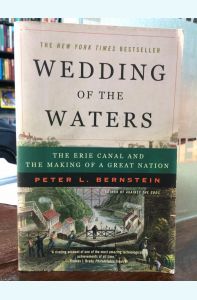"One corner of the great American panorama enlarged to highlight starry-eyed visionaries, political machinations, indefatigable ingenuity, and cockeyed optimism." —Kirkus Reviews
The building of the Erie Canal, like the construction of the Brooklyn Bridge and the Panama Canal, is one of the greatest and most riveting stories of American ingenuity. Best-selling author Peter Bernstein presents the story of the canal's construction against the larger tableau of America in the first quarter-century of the 1800s. Examining the social, political, and economic ramifications of this mammoth project, Bernstein demonstrates how the canal's creation helped prevent the dismemberment of the American empire and knit the sinews of the American industrial revolution. Featuring a rich cast of characters, including not only political visionaries like Washington, Jefferson, van Buren, and the architect's most powerful champion, Governor DeWitt Clinton, but also a huge platoon of Irish diggers as well as the canal's first travelers, Wedding of the Waters reveals that the twenty-first-century themes of urbanization, economic growth, and globalization can all be traced to the first great macroengineering venture of American history.
Editorial Reviews
Amazon.com Review
Begun in 1817 and completed in 1825, the Erie Canal stretches 363 miles across upstate New York from Buffalo on Lake Erie to Albany on the Hudson River. A stunning achievement, the canal was hacked through a densely forested pass in the Appalachian Mountains using only axes, shovels, low-grade explosive power, beasts of burden, and some ingenious devices. The engineers and workers created locks, bypassed rapids and waterfalls, and adjusted to countless changes in elevation. When the canal was completed it became one of the wonders of the world. But the canal was much more than a spectacular construction project; it also served to bind a young United States to itself and the rest of the world in one bold stroke. In this thoroughly absorbing book, Peter Bernstein describes in vivid detail how the Erie Canal helped to shape the United States into a great nation by connecting the eastern seaboard and western expanses of America, as well as propel the Industrial Revolution and stimulate global trade, economics, and immigration. It was so important to the development of the U.S., argues Bernstein, that without the canal the detached western territories "would in all likelihood have broken away" and created another, if not several, separate countries. Manifest Destiny would have been denied.
In telling this gripping tale, the author offers a brief history of canals through the ages, explains the foresight exhibited by George Washington and Thomas Jefferson regarding the need for a waterway to the west, and outlines the political wars, financing challenges, and seemingly endless delays and false starts to the project. He also reveals much about the political landscape of early America through his profiles of the personalities and visionaries who devoted their lives to the project, along with the engineers and surveyors, most of whom had little experience designing or constructing a canal of any kind, much less such a massive undertaking. Wedding of the Waters succeeds brilliantly in bringing this rich story to life. --Shawn Carkonen
From Publishers Weekly
First proposed in 1808 and completed 17 years later, the Erie Canal was the first great feat of macroengineering undertaken by the infant American republic. As economic consultant Bernstein (Against the Gods: The Remarkable Story of Risk) shows in his eloquent account, the canal—stretching 363 miles from the Hudson River to Lake Erie—reshaped not only the economic landscape of the eastern seaboard but the political and social landscape as well. Bernstein vividly relates the political battles fought over the high-priced project and the work of surveyors, engineers and laborers. The canal was in particular an economic engine for New York, bringing down the cost of shipping goods between Buffalo and Manhattan by a whopping 90%. This in turn inspired the development of farms throughout the Great Lakes area and the Upper Midwest. At the same time, prices for farm commodities in Manhattan and other eastern cities dropped steadily, facilitating the growth of industrial workforces and a dramatic shift in the urban-to-rural ratio toward the cities. Bernstein does a first-rate job of examining the social, political and economic impact of the canal both as a construction project and as a viable path linking the Atlantic seaboard with the American interior. 20 b&w illus. not seen by PW.
Copyright © Reed Business Information, a division of Reed Elsevier Inc. All rights reserved.
Product details
|



































